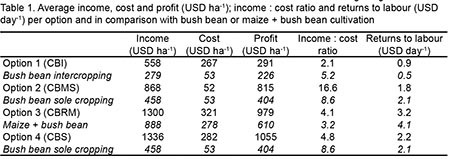Climbing beans are a new crop for farmers in Kapchorwa district, on the northern slopes of Mt Elgon in Uganda. I assessed the effects of the introduction and expansion of climbing bean cultivation at the farm level: what contribution do climbing bean have to food self-sufficiency and income, and what are trade-offs in terms of investment costs and labour. Based on a farm typology and detailed farm characterization (DFC) (Marinus, 2015), we explored the effects of four different options for climbing bean cultivation: Option 1: climbing bean intercropping (CBI) with banana/ coffee; Option 2: climbing bean with maize stalks (CBMS) – relay cropping whereby maize cobs are harvested and stalks are left in the field to serve as stakes; Option 3: climbing beans replace maize (CBRM) – 50% of a maize + bush bean field is replaced with a sole crop of climbing bean; Option 4: climbing bean sole cropping (CBS) with wooden stakes.

|
| Most households participating in the DFC were food self-sufficient in their current situation (Figure 1). Food self-sufficiency was increased with climbing beans in all options, with the exception of option 3: maize yields more in kg of produce and caloric value, so replacing 50% of maize + bush bean with climbing bean was not beneficial for food self-sufficiency. Option 4 provided the largest increase. As prices for climbing bean were better than for maize, the income gained from option 3 was larger than obtained from maize + bush bean cultivation (Table 1). |  |
The other options were compared with bush bean cultivation, as climbing beans would often replace these crops when introduced on the farm. Income increased compared with bush bean cultivation. However, investment costs were also considerably larger because of the staking requirements for climbing bean. Only the maize stalks (Option 2) provide a ‘free’ sources of stakes. Despite the increase in costs, all options resulted in a larger profit than (maize +) bush bean cultivation. Income : cost ratios for climbing beans were not always more favourable. Returns to labour were larger for climbing bean cultivation in Options 1 and 4, but smaller in Option 2 and especially Option 3. All in all, climbing beans could make a great contribution in food self-sufficiency and income, provided that farmers are able to make the necessary investments. Reflection on these outcomes with farmers revealed that, in general, farmers found income more important than food self-sufficiency. Considering the increasing demand for climbing beans and resulting good market prices, farmers indicated they would have to struggle to find capital and labour, but if the beans did well they would be willing to make the additional effort.
Esther Ronner, Wageningen University & Research, The Netherlands (Click here for her 2016 update)
Reference
Marinus, W., 2015. 'Opportunities and constraints for climbing bean (Phaseolus vulgaris L.) cultivation by smallholder farmers in the Ugandan highlands: Developing a ‘basket of options’. Wageningen University, Wageningen.
